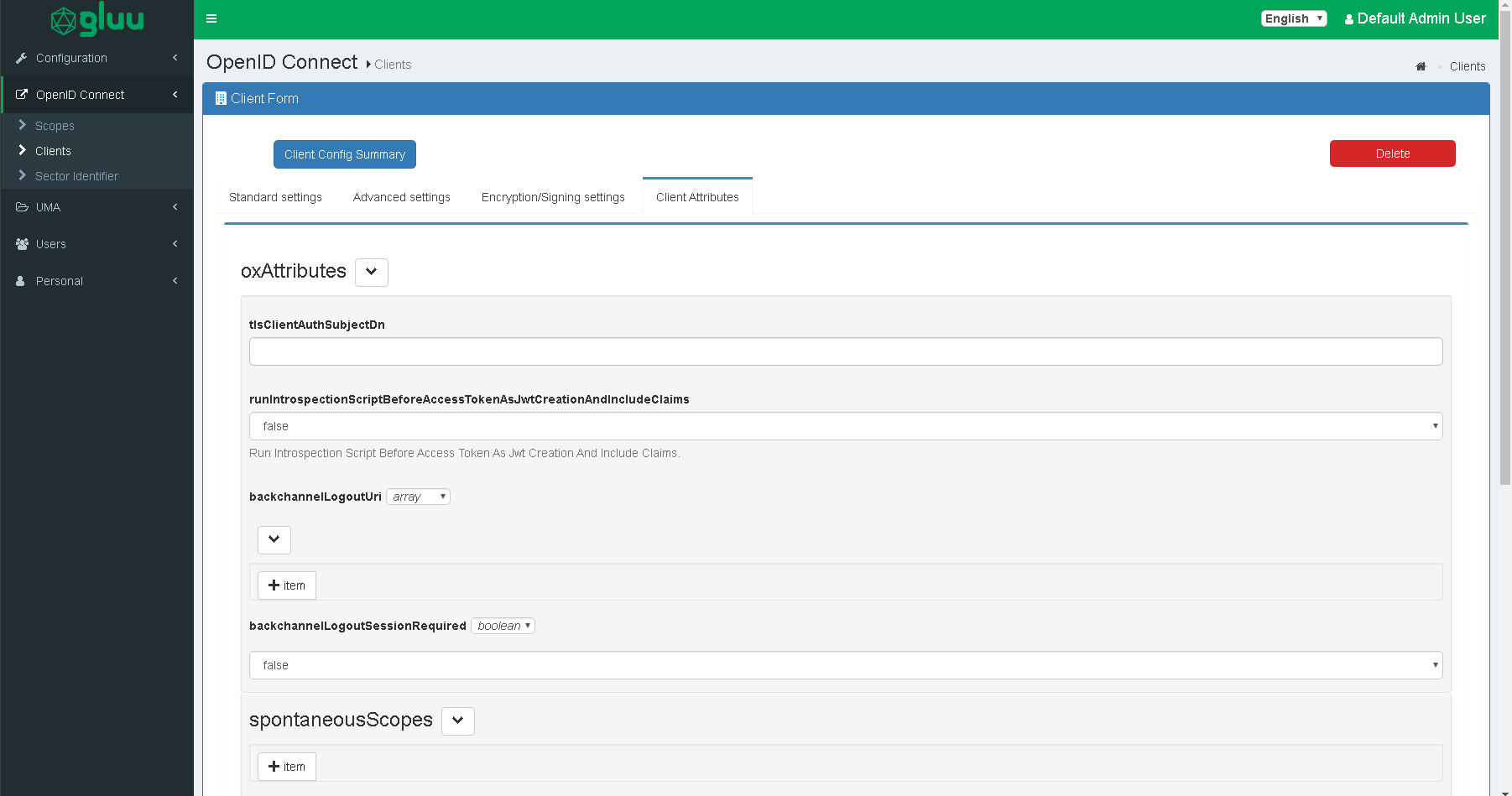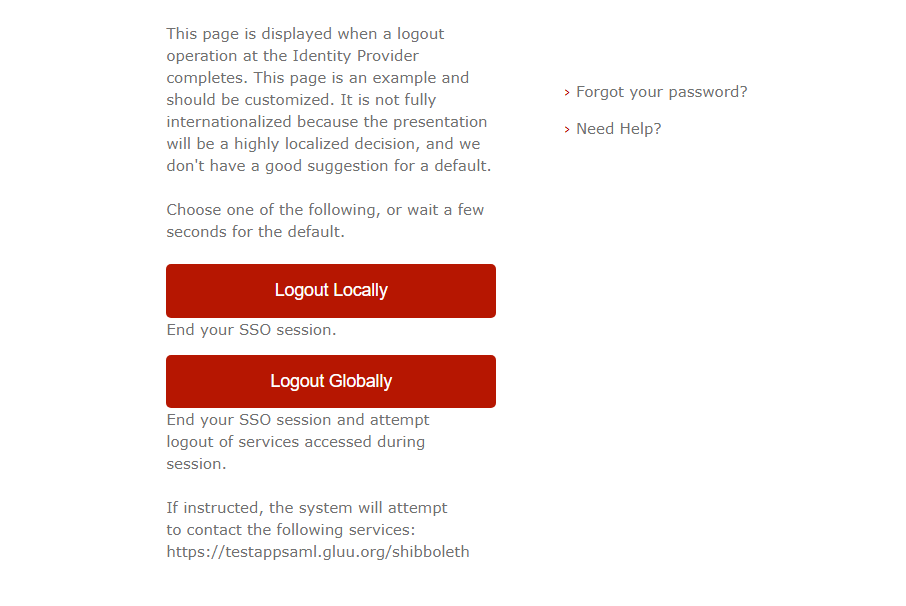Logout from Gluu Server#
OpenID Connect Single Log Out (SLO)#
The Gluu Server uses OpenID Connect to end sessions for logout. Usually a logout link is provided to the connected SP and the session is killed inside the IDP.
When using OpenID Connect Logout, it is recommeneded to use Front-Channel Logout. In Front-Channel Logout the browser receives a page with a list of application logout urls within an iframe. This prompts the browser to call each application logout individually and the OpenID Connect end-session endpoint via Javascript.
The workflow for single logout for two applications using OpenID Connect Front-Channel Logout would be the following:
- App-A - registers
frontchannel_logout_uri_1 - App-B - registers
frontchannel_logout_uri_2 - App-A - login to the Authorization Server (AS), in this case the Gluu Server.
- App-B - login to AS (SSO)
- App-A - calls
/end_session - AS - returns back HTML with iframes where each iframe points to all
frontchannel_logout_uriswithin this session, in our case it isfrontchannel_logout_uri_1andfrontchannel_logout_uri_2 - Browser loads HTML (with all iframes, so it calls
frontchannel_logout_uri_1andfrontchannel_logout_uri_2) - App-A does not know anything about
frontchannel_logout_uri_2, it just calls/end_sessionendpoint and it's the responsibility of the AS to track it and return the correct HTML page with iframes (once iframe is loaded, it means thatfrontchannel_logout_uri_2is called and app-B must log itself out).
There are a few important points to note:
post_logout_redirect_uriis not mandatory by session specification but registration specification saysThe value MUST have been previously registered with the OP. We have dual behavior description directly in specification.oxauthends session successfully (if session is present on OP) independently from whetherpost_logout_redirect_uriis valid or not and will NOT perform redirect. If redirect is requiredpost_logout_redirect_uriMUST be provided. If it is not provided then server returns 400 with messageSession is ended successfully but redirect to post logout redirect uri is not performed because it fails validationand errorpost_logout_uri_not_associated_with_client.oxauthconsider end session without redirect as not proper behavior however it's still up to RP whether to use redirect or not.id_token_hintandsession_idparameters are optional. Therefore OP will end session successfully if these parameters are missed. However from other side if RP included them in request OP validates them and if any of those are invalid OP returns 400 (Bad Request) http code.
post_logout_redirect_uri is validated against client which take part in SSO. If the session does not exist or can not be identified, an error page is shown. However, it is possible to allow redirect to the RP without validation if allowPostLogoutRedirectWithoutValidation is set to true and it is whitelisted via clientWhiteList (by default, the * wildcard is used which makes it white listed).
There is End Session interception script which allows to modify HTML returned during frontchannel logout.
To force id_token_hint presence, please set forceIdTokenHintPrecense oxauth configuration property to true.
The sample End Session script is available here
Read the OpenID Connect Front-Channel Logout Specifications to learn more about logout with OpenID Connect.
Back-channel logout#
It is possible to use backchannel logout. Here is was spec says:
- An upside of back-channel communication is that it can be more reliable than communication through the User Agent, since in the front-channel, the RP's browser session must be active for the communication to succeed.
- A downside of back-channel communication is that the session state maintained between the OP and RP over the front-channel, such as cookies and HTML5 local storage, are not available when using back-channel communication. As a result, all needed state must be explicitly communicated between the parties.
Thus it's up to RP what logout to support, Front-channel or Back-channel.
During client registration it is recommended to specify frontchannel_logout_uri or backchannel_logout_uri. If both are specified then AS perform logout for backchannel_logout_uri (and ignores frontchannel_logout_uri).
During Back-channel logout AS collects all backchannel_logout_uris from all involved clients in SSO session and calls them asynchronously with logout_token.
POST /backchannel_logout HTTP/1.1
Host: rp.example.org
Content-Type: application/x-www-form-urlencoded
logout_token=eyJhbGci ... .eyJpc3Mi ... .T3BlbklE ...
If post_logout_redirect_uri is validated successfully then AS sends redirect to it or otherwise send back OK (200) response code (independently whether involved RPs sends back successfull response or failure).
AS redirect to post_logout_redirect_uri or OK (200) response indicates that AS session is ended. It doesn't mean that all RP's backchannel calls are completed successfully.

Read the OpenID Connect Backchannel Logout Specifications to learn more about logout with OpenID Connect.
Error response#
There are following types of error responses from End Session Endpoint:
1. By default AS returns error as http code and json entity.
2. If allowPostLogoutRedirectWithoutValidation=true and clientWhiteList matches post_logout_redirect_uri then AS redirects to post_logout_redirect_uri without error.
3. If in addition to point 2 there is errorHandlingMethod=remote then AS redirects to post_logout_redirect_uri with error encoded as query parameters.
SAML Logout#
Gluu Server now supports SAML Single Logout. Once it's enabled by the administrator, the logout URL is https://[hostname]/idp/Authn/oxAuth/logout.
The user will be directed to the following confirmation page.

Customizing Logout#
It is possible to use a custom authentication script to call individual logout methods for both SAML and OpenID Connect and log out of the desired SP/RPs when the user logs out of the Gluu Server. Please see the Custom Script Guide to start writing your own custom scripts.